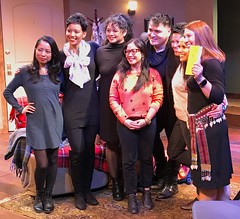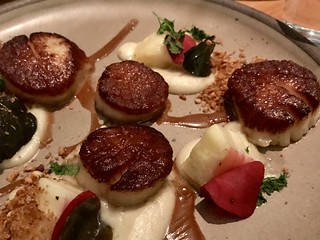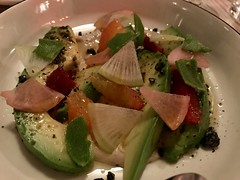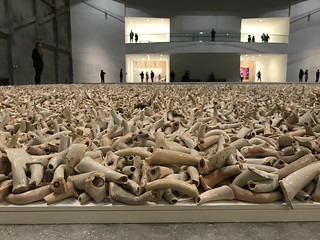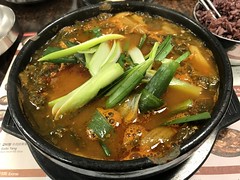After lunch in Koreatown, in another of my off-Friday pairings of food and art explorations, I got to see a couple of impressive art installations at the
Marciano Art Foundation. (If you haven’t yet been to the MAF, it’s a fantastic recent addition to the LA modern art scene, completely free including parking, but you need to make online reservations, and it’s currently booked out about a month out.) The first was a set of massive installations by Ai Weiwei. I’ve gotten to know this artist in the last year, not only through a
previous exhibition, but also through his impressive documentary film Human Flow, about refugees and mass migrations, and it’s interesting to see the themes that connect his works. He is fascinated with scale and replication, and one of the things he likes to do is create large installations comprised of large numbers of the same kind of object, inviting you to look at an overall mass, contemplating vastness and large numbers, but at the same time to look closely at individuals and see what appear to be replicas actually have individual differences and characteristics. In the previous exhibit, he did that with antique Chinese stools filling a large open gallery. The Marciano offered an even bigger space to fill, and he’s filled it with two installations of this sort. One, called Spouts, is a nearly 2000-square foot rectangle filled with the spouts of antique porcelain teapots. These are broken fragments of pottery from various Chinese dynasties, some as much as 1000 years old. The shapes and colors vary, though they’re mostly shades of white and ivory. Given that the artist has spent time in Chinese prison and under house arrest, one can imagine this mass of teapot “mouths” to be a comment on the freedom of speech for all the people in China. The other, called Sunflower Seeds, is an even bigger square, over 4000 square feet, filled with sunflower seeds. Not real ones, but lifesize porcelain replicas. There are about 50 million of them, made by over 1600 artisans in Jingdezhen, a town with a long tradition of porcelain craftswork. Thinking about the fact that each of these seeds was handmade by an artisan, and looking at this vast field of millions of them, makes you think about the value of handicraft and the price of labor in China.
 |
| The large field in fore are the 50 million porcelain sunflower seeds. The ivory rectangle beyond that are the antique teapot spouts. |

Beyond these two fields is another space that houses a bunch more works by Ai Weiwei, these works all made of bamboo and silk, using the techniques of traditional Chinese kite-making. In the center of the space is the featured Life Cycle, a lifesize large inflatable Zodiac-style boat filled with human figures, made entirely of slender bamboo sticks. If you’ve seen his film, or if you’ve seen any documentary footage of refugees crossing the Mediterranean Sea trying to reach Europe, you will recognize the scene immediately. These are the sort of boats refugees often use, filled to dangerous overcapacity. Sometimes they even capsize. The figures in this boat are all facing inward, and you can see that the center is filled with figures too. A child peers over the front. The transparent bamboo construction of the figures makes them ghostly, just outlines of people, hard to make out. These boats often make their desperate runs at night. After a while you notice that while most of the figures are human, every so often the artist has topped a human body with the head of animals from the Chinese zodiac, an ox here, a rooster there. Perhaps that’s a play on Zodiac, the most common maker of these inflatable boats. Perhaps it suggests the hope that there might be some guiding spirits or angels traveling with these desperate boats. In any case, it’s a powerful piece.
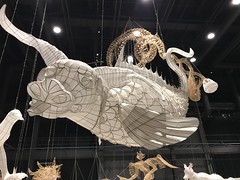
Surrounding the Life Cycle, on the walls around it, and suspended in the rafters above it, are a myriad of bamboo-and-silk kite-like works. The ones flying above are all fantastic mythical creatues drawn from an ancient Chinese mythological text called the Shanhaijing. These creatures have arms and wings, fins and tails, some have multiple heads. The white silk creatures lit up against very high rafters that disappear into darkness create a fantastic effect, like constellations floating in a night sky. The works along the wall draw on myth, on modern art, and on themes from the artist’s life and work. In one section I smiled to recognize the three-legged stools echoing another work I had seen last fall.
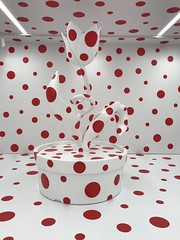
This alone would have been treat enough, but on another floor, MAF was hosting another large scale installation by a fascinating artist. Yayoi Kusama, the Japanese artist whose amazing Infinity Room has been such a hit at The Broad, has another immersive installation here. This one is entitled With All My Love For The Tulips, I Pray Forever. The title gives you a hint of the playful fantasy to expect. This work comprises several monumental potted tulips in a large room, where the tulips themselves, along with the entire room – walls, ceiling, floor – have been painted bright white with large bright red polka dots. It is a fantastic effect, and as you don shoe coverings to be able to walk into this joyful artwork, I think it is impossible not to smile. With absolutely everything in your field of view the same bright colored pattern, Kusama plays with your sense of depth and dimension, while the fancifully shaped oversize tulips create a Wonderland effect. Just how big are those tulips? Wait, have I shrunk? With nothing around you but bright dots, fantastic flowers, and smiling spectators, this exhibit most definitely sparks joy.
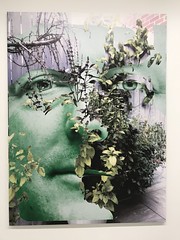
Beyond this, there was still more to explore. The MAF has a large permanent collection that they rotate through exhibition, and judging by the very recent dates on some of the works I saw today, they are actively continuing to expand their collection. Mimi Lauter has a gorgeous 8-panel abstract painting in brilliant peacock hues. A wall full of different colored mirrored windows forms the “clockwork for oracles” by Ugo Rondinone. Photographer Catherine Opie has a fascinating series of intimate photos from inside Elizabeth Taylor’s home (not of Ms. Taylor, just of her home and her stuff). Urs Fischer has created a series of intriguing self-portraits spliced onto scenery, using cuts and color washes and creative construction. These are just some of the highlights. This museum is really such a treat.

